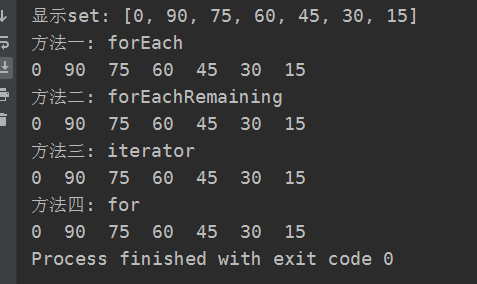基本用法
(1) boolean add(type); 给指定集合添加一个元素
(2) boolean contains(Object obj); 如果hashSet中存在指定元素,contains()方法成功返回true
(3) boolean remove(Object obj); 删除元素obj并返回true,若不存在返回false
(4) boolean isEmpty(); 判断set是否为空集合,为空返回true
(5) int size(); 返回集合中存在的元素数量
(6) void clear(); 删除引用集合中存在的所有值,成为空集合
import java.util.*; public class NewTips { public static void main(String[] args) { // 初始化 HashSet<Integer> set = new HashSet<>(); System.out.println("----------add:--------"); System.out.println(set.add(1)); System.out.println(set.add(99)); System.out.println(set.add(78)); System.out.println(set.add(1)); System.out.println("显示set: "+set); System.out.println("--------contains:------"); System.out.println(set.contains(1)); System.out.println(set.contains(2)); System.out.println("---------remove:-------"); System.out.println(set.remove(1)); System.out.println(set.remove(1)); System.out.println("---------isEmpty:-------"); System.out.println(set.isEmpty()); System.out.println("---------size:-------"); System.out.println(set.size()); System.out.println("---------clear:-------"); set.clear(); System.out.println("显示set: "+set); } }

数据遍历
(1)forEach()
(2)forEachRemaining()
(3)迭代器使用
(4)for循环
import java.util.*; public class NewTips { public static void main(String[] args) { // 初始化 HashSet<Integer> set = new HashSet<>(); for(int i=0; i<100; i+=15){ set.add(i); } System.out.println("显示set: "+set); System.out.println("方法一: forEach"); set.forEach(e->System.out.print(e+" ")); System.out.println(); System.out.println("方法二: forEachRemaining"); Iterator<Integer> iter1 = set.iterator(); iter1.forEachRemaining(e->System.out.print(e+" ")); System.out.println(); System.out.println("方法三: iterator"); Iterator<Integer> iter2 = set.iterator(); while (iter2.hasNext()) { System.out.print(iter2.next()+" "); } System.out.println(); System.out.println("方法四: for"); for(Integer e : set){ System.out.print(e+" "); } } }
